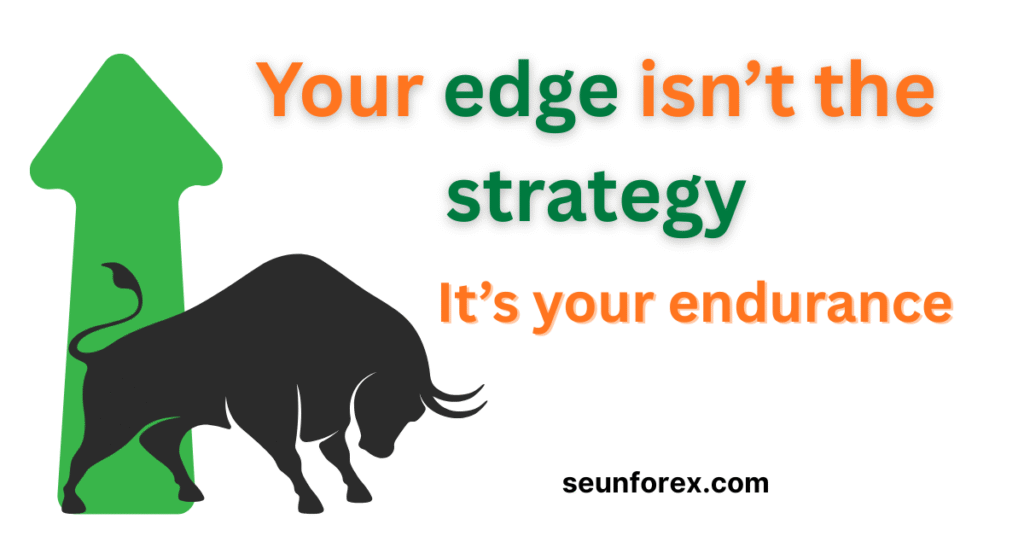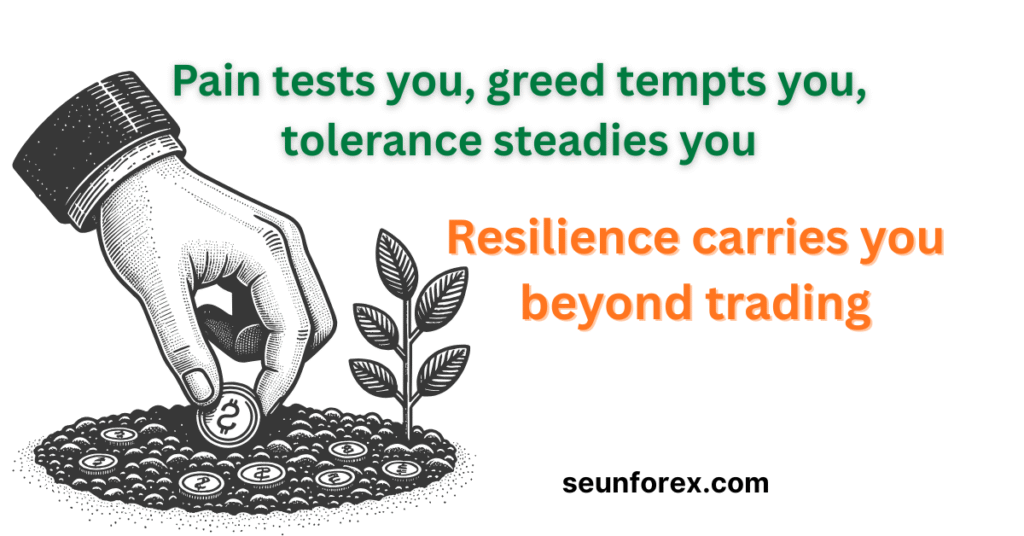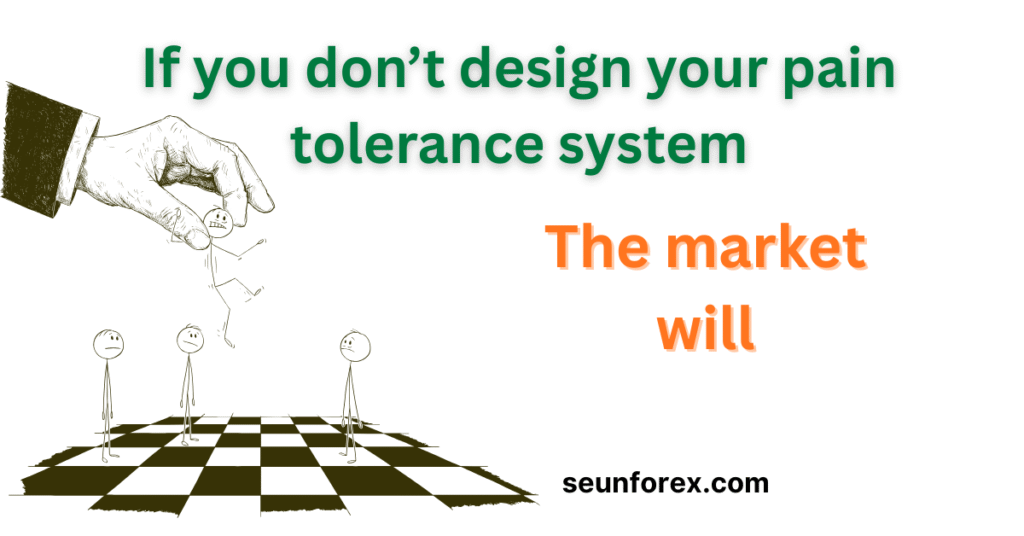
🔻 The Chart Broke Me Before the Market Did
I still remember that morning like it was yesterday. My desk lamp was on, the air was quiet, and the charts stared back at me with their merciless red candles.
This wasn’t just about losing money.
This was about losing faith.
Weeks of late nights reading trading books. Hours of YouTube videos explaining setups. Days spent backtesting strategies that promised consistency. A journal filled with trade logs, notes, and affirmations.
And yet… it still ended the same way:
Pain.
The kind of pain that doesn’t just sit in your account balance — it sits in your chest.
In trading, they call this pain tolerance in trading — the invisible threshold where financial losses meet mental exhaustion. It’s not just numbers on a chart; it’s the breaking point where traders start doubting if they belong in the markets at all.
No one talks about this stage enough. The stage where quitting feels smarter than continuing.
Not because you’re lazy. Not because you don’t care. Not because you lack discipline.
But because your heart is tired. Because the weight of emotional drawdown lingers longer than any losing streak.
And you whisper to yourself the question every struggling trader has asked at some point:
“Is this really worth it?”
😵💫 The Hidden Cost of Trading: Emotional Capital
We talk a lot about money in trading. Profit targets, risk-to-reward ratios, account sizes, daily drawdowns. But few traders talk about the other currency — the one that really determines whether you survive or quit.
That currency is emotional capital.
You only have so much patience. So much belief. So much faith in your system before the doubts pile up heavier than your reasons to continue.
And here’s the truth:
This isn’t about whether you understand how to use a moving average, Fibonacci retracement, or order block.
It’s about something much deeper:
👉 Watching your confidence erode with every failed setup.
👉 Wondering if you’re delusional for still believing in this dream.
👉 Carrying the weight of “what if I’m wasting years of my life?”
Trading legend Mark Douglas put it bluntly:
“The market is designed to test you. Not financially first — emotionally.”
That’s why most traders don’t quit because of money alone.
They quit because they lose hope.
Emotional Drawdown vs. Financial Drawdown
Financial drawdown is easy to measure: account percentage lost, equity decline, or PnL. But emotional drawdown is harder. It doesn’t show up in your broker statement — it shows up in your mind.
Emotional drawdown looks like:
- Hesitating to take a setup you know is valid.
- Over-leveraging because you want to “make it back faster.”
- Closing trades too early out of fear.
- Avoiding the charts entirely because the pain feels unbearable.
Every trader has faced this invisible drawdown, but few admit it. That silence makes many beginners believe they’re alone, when in reality, even professional traders face the same cycles of doubt and recovery.
The good news? Just like a financial drawdown, emotional drawdown can be managed, recovered from, and eventually minimized with the right practices.
💣 Step One: Accept That You’re Not Broken — You’re Processing
If you’re here right now, standing at the edge of doubt, I want you to know something important:
👉 You’re not broken.
👉 You’re not weak.
👉 You’re not hopeless.
What you’re experiencing is part of the process.
Yes, even the doubt.
Yes, even the tears.
Yes, even the rage when a paper trade works perfectly but your live account falls apart.
That isn’t proof you’re not cut out for trading.
It’s proof that you care deeply.
And caring deeply is both a curse and a gift in this game.
Because while passion keeps you learning, it also makes the losses cut ten times deeper.
This is where pain tolerance in trading becomes the real edge. Not the strategy, not the setup, not the textbook theory — but your ability to carry that emotional weight without breaking. The market doesn’t just test your account balance, it tests your emotional reserves, and when those reserves run low, that’s when emotional drawdown takes hold.
But here’s the hidden secret most traders never hear:
Feeling emotional pain isn’t a sign you should quit.
It’s a sign you’re processing the reality of what trading really demands.
And what it demands, above all else, is the strength to withstand both financial losses and the invisible cost of emotional drawdown.
🚑 Step Two: Redefine What Pain Means in Trading
Most traders treat pain as a warning signal. “I’m losing money. This hurts. I should stop.”
But here’s the uncomfortable truth: pain in trading is feedback, not failure.
It’s the same way muscles grow in the gym. The soreness after lifting weights isn’t a sign you’re injured (unless you truly overdo it). It’s a sign your body is adapting, reshaping, building strength.
In the same way, losses, setbacks, and emotional drawdown aren’t punishments — they’re signals.
Signals that your risk might be too big.
Signals that your strategy needs refinement.
Signals that your mind needs more conditioning.
When you stop interpreting trading pain as a stop sign and start treating it as feedback, you shift from victim to student.
That shift is everything.
Because pain tolerance in trading isn’t about ignoring pain. It’s about listening to pain correctly — filtering the message without letting it destroy your motivation.
💡 Actionable Exercise:
- After every loss, write down:
- What the chart did.
- What you did.
- What you felt.
- What you learned.
When reviewed over weeks, this “Pain Journal” becomes your personal playbook. Instead of fearing emotional drawdown, you’ll start seeing patterns in how you react — and those patterns will become your training ground.
Step Three: Emotional Risk Management
We’re all taught financial risk management: don’t risk more than 1-2% per trade, calculate position sizes, use stop losses.
But what about emotional risk management?
Think about it. Even if you’re only risking 1% of your account, what happens when you take five consecutive losses?
Mathematically, it’s survivable.
Emotionally, it feels like the end of the world.
This is why traders sabotage themselves. Not because they lack technical skill, but because they’ve exhausted their emotional capital.
So how do you manage emotional risk?
- Limit exposure time: If you’ve had 2 losses in a day, stop trading. Not for your account — for your mind.
- Schedule recovery days: Just like athletes need rest days, traders need breaks after heavy losses. No charts, no news, no obsessing.
- Scale size during drawdowns: Cut risk per trade in half until you regain confidence. This reduces pressure while keeping you engaged.
Managing emotional risk is about respecting your psychological limits as much as your account limits.
Because no trader quits after losing $50. They quit after losing $50 plus their belief that they can recover.
The Spiral of Emotional Drawdown
Let’s map what really happens when traders hit an emotional drawdown:
- Initial Losses: The first few losing trades sting but seem normal.
- Doubt Creeps In: You start questioning your system and second-guessing entries.
- Revenge Trading: You increase lot size to “make it back” faster.
- Bigger Losses: Now the account is bleeding, and panic sets in.
- Hopelessness: You stop following your plan, avoid charts, and feel like quitting.
This spiral happens to almost every trader.
And the only way out isn’t to double down or ignore the pain. It’s to recognize that you’re in the spiral and consciously step back.
🔥 Practical Reset Strategy:
When you recognize emotional drawdown is taking over:
- Stop trading immediately.
- Switch to demo for a week. Rebuild confidence without pressure.
- Review journal. Identify whether the problem was strategy or execution.
- Set micro goals. Instead of aiming for $500, aim for three disciplined trades in a row.
This process may feel slow, but it rebuilds trust — in yourself and in your edge. Without trust, no amount of technical analysis will save you.
🌱 Why Pain Tolerance Builds Resilience Beyond Trading

Here’s the secret nobody talks about: learning pain tolerance in trading doesn’t just make you a better trader.
It makes you a stronger human.
The ability to endure drawdowns, rebuild after setbacks, and keep your emotions in check translates into every part of life:
- In business: handling rejection without giving up.
- In relationships: managing conflict without walking away.
- In personal goals: sticking to long-term visions even when results are delayed.
That’s why so many successful traders describe their biggest losses as their greatest teachers.
Because trading isn’t just about charts. It’s about training the mind to function under pressure.
And when you master pain tolerance here, you unlock resilience everywhere else.
🪞 Step Four: Separate Identity from Outcome
One of the deepest mistakes traders make is attaching identity to results.
- “I lost money today. I’m a failure.”
- “I blew my account. I’m not cut out for this.”
- “I missed the setup. I’m worthless.”
This is the voice of emotional drawdown.
But here’s the truth:
👉 A losing trade doesn’t make you a losing trader.
👉 A blown account doesn’t define your destiny.
👉 A setback doesn’t erase your potential.
You are not your PnL.
You are not your worst week.
You are the collection of lessons you’ve learned, the hours you’ve studied, and the resilience you’re building day by day.
The market doesn’t care about you personally — and that’s liberating. Because it means your worth isn’t tied to a chart.
Your only job is to show up, execute your plan, and manage risk — both financial and emotional. The outcomes will fluctuate, but your identity should remain unshaken.
📌 Mindset Hack:
Instead of saying “I lost $100,” reframe it as “I paid $100 for today’s lesson.”
That one reframe will protect your emotional capital more than any indicator ever could.
🛡️ Step Five: Build Your Recovery System Before You Need It
Here’s a paradox: most traders only think about emotional recovery after they’re already in pain.
But the strongest traders design recovery systems in advance.
Your recovery system might include:
- A supportive community of traders to remind you you’re not alone.
- A physical activity (gym, running, walking) to process stress.
- A rulebook of when to stop trading.
- Affirmations or journaling rituals to re-anchor belief.
Think of it like an emergency exit plan. When fire breaks out, you don’t want to invent a way out. You want to already know where the door is.
By preparing for emotional drawdown in advance, you turn crisis moments into temporary setbacks instead of permanent quitting points.
🧠 The Science Behind Pain Tolerance in Trading
Psychologists describe pain tolerance as the maximum level of pain an individual can endure before it becomes unmanageable.
In trading, this translates to the ability to handle repeated stress without impulsive reactions.
Science shows that resilience isn’t fixed — it’s trainable. The more controlled exposure you give yourself to stress (small losses, setbacks, pressure), the stronger your nervous system becomes at handling it.
That’s why demo trading, small lot sizes, and gradual scaling aren’t signs of weakness — they’re the scientific way to build mental muscle.
So when you hit your next losing streak, don’t view it as the end. View it as resistance training for your mind.
📖 Case Studies: When Pain Builds Traders, Not Breaks Them
Sometimes the best way to understand pain tolerance in trading is through stories. Let’s walk through three powerful examples:
1. The Retail Trader Who Blew 5 Accounts
I knew a trader who blew not one, not two — but five accounts. Every time, he swore it was his last attempt. But something in him refused to let go.
Instead of quitting, he treated each blown account as tuition. He journaled his mistakes, reduced his position sizes, and invested more in education.
By the sixth attempt, he was profitable. Not because the market suddenly got easier — but because his pain tolerance finally matched his ambition.
2. The Prop Firm Swing Trader
A swing trader I met through a community passed a prop firm challenge on his second try. But during the first attempt, he came within $200 of the target before losing everything.
He admitted the financial pain was nothing compared to the emotional one. “I felt like a fraud. Like I wasn’t cut out for this.”
What saved him wasn’t a new strategy. It was stepping away, journaling, and confronting the truth: he was over-leveraging because he was rushing success.
On the second attempt, he slowed down. Same setups, smaller size. This time, he passed.
His edge wasn’t the system — it was his ability to endure the pain of failure without quitting.
3. The Veteran Professional
Even professional traders face emotional drawdown. One veteran with 15 years of experience told me:
“The market doesn’t get easier. You just get stronger.”
He described losing six figures in a single week during a crisis. He didn’t quit because he had built systems around his emotional capital: mentors, therapists, routines, and risk protocols.
His survival wasn’t because he had more knowledge than a retail trader. It was because he respected pain as part of the profession.
These stories prove one thing: pain tolerance isn’t optional — it’s the foundation of long-term survival.
🧩 Designing Your Pain Tolerance System

If you want to last in this game, you can’t just “wing it” emotionally. You need a structured system. Here’s a framework:
1. Pre-Trade Emotional Check
Before entering a trade, ask:
- Am I calm or chasing?
- Am I trading my edge or my fear?
- Can I emotionally afford this loss if it happens?
If you can’t answer “yes” with clarity, don’t trade.
2. Mid-Trade Neutrality
During the trade:
- Stop staring at every candle.
- Set alerts at critical levels.
- Detach by focusing on process, not outcome.
The less you feed emotional attachment during the trade, the more tolerance you preserve.
3. Post-Trade Rituals
Win or lose, do the same ritual:
- Journal the setup.
- Record your emotions.
- Reward yourself for discipline, not outcome.
This creates consistency and avoids the dopamine trap of only celebrating wins.
4. Emotional Stop-Loss
Every trader sets a financial stop-loss. But do you set an emotional stop-loss?
Example:
- After 2 losses in a day, stop.
- After 3 consecutive emotional trades, take 24 hours off.
- After a blown week, reduce size by half next week.
Protect your emotional capital as aggressively as you protect your financial capital.
🔄 Emotional Resets That Actually Work
When emotional drawdown strikes, these resets are proven to help:
- Physical Reset: Exercise. Movement clears mental fog.
- Environmental Reset: Change location. Trade in a café, park, or different room.
- Social Reset: Talk to another trader. Share pain. Remind yourself you’re not alone.
- Creative Reset: Do something artistic — writing, music, design. It rewires your focus away from charts.
Pain tolerance in trading isn’t about suppressing emotions. It’s about releasing them safely so they don’t sabotage your next decision.
🌟 Rebuilding Confidence After Emotional Drawdown
When your emotional reserves are empty, rebuilding seems impossible. But here’s a 3-step method:
Step 1: Micro Wins
Forget about making $500. Focus on one disciplined trade. One journal entry. One day without overtrading.
Confidence rebuilds from consistency, not profit.
Step 2: Study Survivors
Read books, interviews, and stories of traders who survived worse than you. Realize your pain isn’t unique — it’s part of the profession.
Step 3: Visualize the Comeback
See yourself trading with calmness, patience, and resilience. Your mind can’t tell the difference between vivid visualization and real experience. Train your comeback mentally before it happens physically.
🔒 Closing Perspective: Pain as the Price of Admission
Here’s the truth no one wants to hear:
👉 Pain tolerance in trading isn’t something you avoid.
👉 Emotional drawdown isn’t something you escape forever.
👉 Both are the price of admission into this profession.
You can’t bypass it. You can only prepare for it, endure it, and grow from it.
The traders who survive are not those who avoid pain — but those who integrate it into their growth.
📌 If you’ve ever felt like you’ve lost everything and wondered whether to quit, read this guide on bouncing back after losing everything in forex trading — it will remind you that loss isn’t the end, it’s a reset.
🎤 Final Thoughts: The Market Didn’t Break You — It Shaped You
The chart may feel like it broke you. The red candles may feel like knives in your chest. The emotional drawdown may feel endless.
But if you’re still here, still reading, still breathing…
You’re not broken.
You’re being shaped.
Because the comeback isn’t built on avoiding pain. It’s built on tolerating it, processing it, and walking back to the chart with patience and persistence.
The market will still be here tomorrow.
The question is — will you?
And if you choose to stay, remember this truth:
“The edge is not the strategy. The edge is your ability to endure pain without quitting.”